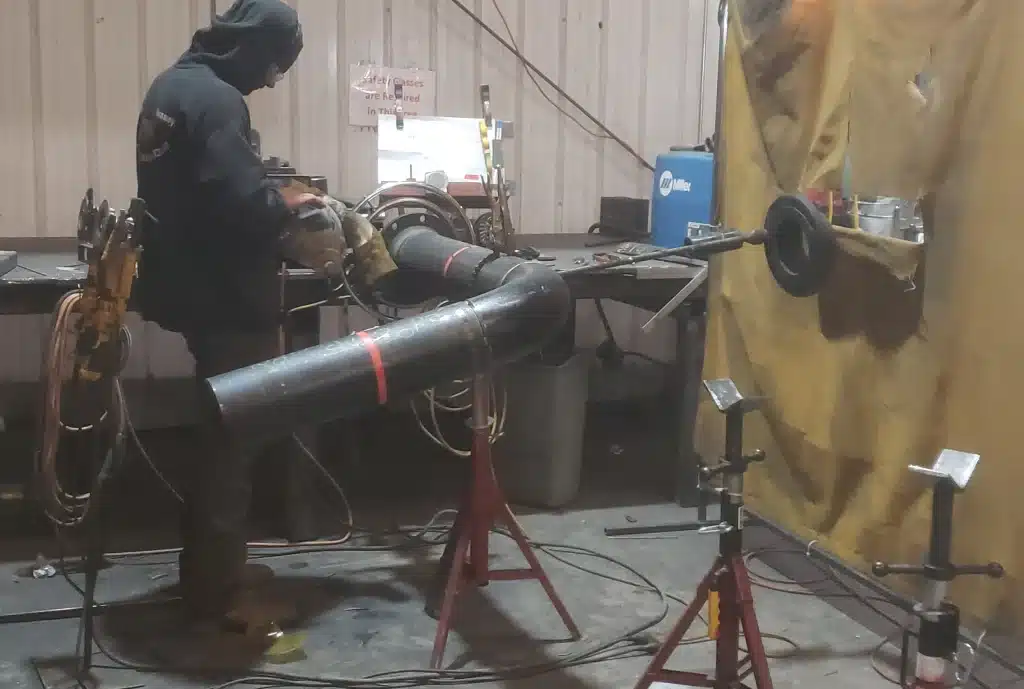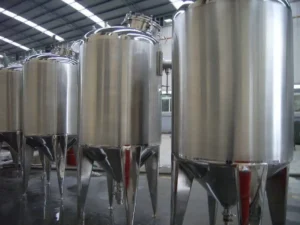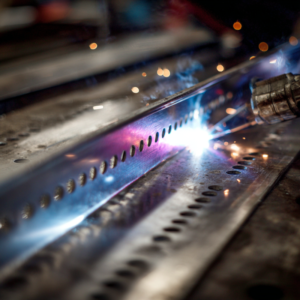
Introduction to the different types of pressure vessel stress
Pressure pots are like the tough guys of the industrial world, dealing with all sorts of pressures, both inside and out. Getting the lowdown on the different pressures they face is key to keeping them strong and in the game. Here’s the scoop on the main pressures these bad boys tackle:
Circumferential Stress, a.k.a. The Squeeze Play:
- Imagine the pressure of trying to pop the vessel open like a soda can. That’s the hoop stress, doing its thing around the vessel, usually the top dog of stresses in a cylinder-shaped pressure pot when it’s under internal pressure.
Longitudinal or Axial Stress, The Stretch:
- Description: This stress acts along the length of the vessel, from one end to the other (top to bottom). In a cylindrical vessel under pressure, it’s usually less intense than hoop stress, roughly half as strong.
- Effect: The vessel stretches lengthwise due to internal pressure, and while it’s not as dominant as hoop stress, it still plays a crucial role in the vessel’s structural integrity.
Radial Stress, The Innie:
- Description: Radial stress is the force that pushes inward, from the outer surface toward the inner surface of the vessel. In thin-walled vessels, radial stress is minimal compared to axial and hoop stresses.
- Effect: This stress acts as a whisper in thin-walled vessels, often overshadowed by other stresses. However, in thick-walled vessels, it can become significant.
Thermal Stress, The Hot & Cold:
- Description: When a vessel experiences temperature changes, thermal stress causes it to expand or contract. This stress arises from the difference in temperature between various parts of the vessel.
- Effect: Thermal stress can create added tension, especially if different areas of the vessel heat or cool unevenly. It contributes to the potential for cracking or fatigue over time.
Stress Concentration, The Drama Queen:
- Description: This stress occurs at points of abrupt shape changes, like nozzles, attachments, or sharp edges. These areas can experience much higher stress than the rest of the vessel.
- Effect: Stress concentrations are localized high-stress areas that make certain spots more prone to failure, often due to design choices that disrupt the smooth stress distribution.
Bending Stress, The Lean:
- Description: Bending stress arises from external loads, poor installation, or uneven support. Long, slim vessels are particularly susceptible.
- Effect: This stress can cause the vessel to bend or deform, compromising its structural balance. Improper support or mounting can intensify this stress, leading to warping.
Vibrational or Dynamic Stress, The Shaker:
- Description: Vibrational stress results from equipment vibrations, fluid movement, or external vibrations. This type of stress is often cyclical, as it comes and goes with the vibrations.
- Effect: Over time, vibrations can lead to fatigue and cracking, as repeated shaking wears down the material. Proper design and support help mitigate these stresses.
Compressive Stress, The Squeeze:
- Description: While pressure vessels generally face tension from internal pressure, they can also experience compressive stress from external forces or cooling.
- Effect: Compressive stress can cause the vessel to contract or “squeeze,” especially in situations like low temperatures. This stress is critical in applications where external pressures are prevalent.
Fatigue Stress, The Tired Out:
- Description: Fatigue stress results from repeated cycles of loading and unloading, such as filling and emptying the vessel.
- Effect: Over time, this stress can weaken the material, even if each cycle’s stress level is within safe limits. Fatigue can lead to cracks and eventual failure.
Corrosion-Induced Stress, The Eater:
- Corrosion can thin out areas, leading to more stress. Plus, mix in tension with a corrosive environment, and you’ve got a recipe for stress corrosion cracking.
Residual Stress, The Leftover:
- These are the stresses that stick around after manufacturing or welding. If they’re not chilled out properly, like through post-weld heat treatment, they can mess with the vessel’s vibe.
Why Stress Analysis is a Big Deal:
- Safety First: Pressure vessels have to handle a lot, and a failure could be disastrous, leading to injuries, property damage, or worse. Making sure they can deal with all possible stresses is crucial for keeping things safe.
- Efficiency = Savings: A vessel designed to handle its stresses well needs less fix-up and lasts longer, saving cash over time.
- Playing by the Rules: Following standards set by big names like the ASME is not just smart; it’s often the law, ensuring vessels are up to snuff on handling stress.
The Manufacturer’s Playbook:
- Choosing the Right Stuff: Selecting the best material based on what the vessel will face, from the environment to what it’s holding, is step one.
- Designing to Dodge Stress: Using tools like Finite Element Analysis (FEA) helps in tweaking the design to handle all stresses like a champ.
- Smart Building Moves: The way a vessel is put together, especially with welding, can introduce stress points. Skilled welding and treatments post-weld can smooth these out.
- Testing, Testing: Before a vessel hits the field, it’s put through the wringer with tests like hydrostatic and non-destructive testing to catch any flaws.
Keeping It Real on the Field:
Even after a vessel is out there doing its thing, keeping an eye on it with inspections and maintenance is key to catching and fixing any issues, from wear and tear to damage, ensuring it keeps doing its job safely and effectively.
In essence, understanding and managing the various stresses on pressure vessels is crucial from the drawing board to the field, ensuring they perform safely and efficiently throughout their life in the industrial world.
Need a reliable partner?
Red River specializes in the design and manufacturing of pressure vessels. We also fabricate related items such as prefabricated spools and skid packages.
Reach Out to us today and experience the Red River difference. Where American Made and American Values come together, we care more.
FAQ: Understanding Different Types of Pressure Vessel Stress
1. What are the primary types of stress encountered in pressure vessels?
Pressure vessels are subjected to various types of stress, primarily categorized into three groups: membrane stress, bending stress, and peak stress. Membrane stress occurs uniformly over the thickness of the vessel wall, typically caused by internal pressure. Bending stress is due to loads that cause the vessel to bend, such as weight and external forces. Peak stress is localized and occurs at points of discontinuity like nozzles or junctions where different stresses concentrate.
2. How does thermal stress impact pressure vessels?
Thermal stress in pressure vessels arises due to temperature gradients within the vessel material or between the vessel and its contents. When different parts of the vessel expand or contract at different rates due to temperature changes, it creates stress. This is particularly critical in vessels undergoing rapid temperature changes or those operating at high temperatures, as it can lead to material fatigue or failure if not properly managed.
3. Can corrosion lead to stress in pressure vessels?
Yes, corrosion can significantly contribute to stress in pressure vessels. Corrosive environments can weaken the vessel material, leading to a reduction in thickness and, consequently, an increase in stress due to internal pressure. Pitting corrosion, in particular, can lead to stress concentration points, increasing the risk of crack initiation and propagation.
4. What role does fatigue play in the stress of pressure vessels?
Fatigue stress is a critical concern in pressure vessels, especially those subjected to cyclic loading conditions. Repeated application of stress, even if it’s below the material’s yield strength, can lead to the gradual development of cracks and eventual failure. This is why understanding the fatigue life of the material and the operational cycles of the vessel is essential in design and maintenance.
5. How do design features influence stress distribution in pressure vessels?
The design of a pressure vessel significantly influences how stress is distributed across its structure. Features like shape, size, and the presence of discontinuities (like nozzles, joints, or changes in thickness) can create areas of stress concentration. For instance, spherical vessels typically experience more uniform stress distribution compared to cylindrical ones. Similarly, the placement and design of reinforcements around openings can mitigate stress concentration effects.
Related Blog Post

How a Glycol System Works

Ethylene Glycol Water: A Complete Heat Transfer Guide

Water Filter Replacement

Why Use Stainless Steel Sheet Metal Fabrication?

How Does Stainless Steel Sheet Metal Fabrication Work
About Author

